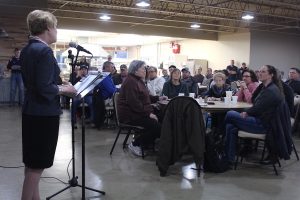LAKEVILLE, Ohio — Nearing the completion of her meet-and-greet sessions, Ohio’s newest director of agriculture, Dorothy Pelanda, told farmers from Wayne, Holmes and Ashland counties that she wants them to be included as decisions are made.
Pelanda spoke over breakfast March 13, at Round Lake Christian Camp, just north of Loudonville. Most of her talk was about improving water quality, and also issues related to farm profitability, and commercial dog breeder licensing.
Water quality has been a priority since she took office in January, and was a priority of the John Kasich administration. Pelanda said her team is reviewing the executive order, signed by Kasich last July, but in a way that puts the measure on hold, so farmer input can be considered.
The order would have declared eight northwestern Ohio watersheds to be in distress, and required new rules for the state’s farmers, which many said were too onerous and not likely to result in the swift action the former governor sought. Conservation leaders were also concerned, citing staff and funding limitations, and the cost of getting thousands of farmers to follow new rules.
On hold
Pelanda said Gov. Mike DeWine has “basically pushed the pause button” on the Kasich order, but she assured the group that water quality is still the top priority, with meetings that are held each week by ODA, the Department of Natural Resources and Ohio EPA — to discuss the best course of action.

The state’s biggest water quality issue has been with Lake Erie, where farm nutrient runoff, and runoff from municipal and residential waste has led to harmful algal blooms, which threaten the safety and usability of the lake’s water.
However, Pelanda said DeWine is focused on water quality solutions for all of Ohio’s 88 counties, including the southern two-thirds of the state, which flows to the Ohio River and into the Mississippi.
The DeWine administration announced more than $20 million in funding in February, intended for improvements in the western Lake Erie basin, and the governor is planning more funding in his statewide budget proposal, to be released March 15.
More to come
According to Pelanda, the governor will announce a new program called the H2-Ohio Fund — a targeted water quality approach for the whole state.
Farmers and commodity groups have been supportive of water quality improvement in Ohio, investing millions of dollars into on-farm research, and trying new farming practices intended to keep nutrients in place. They’ve been concerned, however, that regulations not get ahead of the science, which continues to develop as new farming practices are studied.
“We can’t ask farmers to do these things without the government stepping in and helping them financially,” Pelanda said. “And helping be a team together to figure out what the problems are, and what’s working and what’s not working.”
Taking action
She said the solutions will take time — but that there is enough data already collected to explore some “shovel-ready ideas.”
Pelanda is hosting events across the state this week, in celebration of Ohio Agriculture Week, March 10-16. Additional meetings are scheduled through April 12, and can be found online at www.agri.ohio.gov. She said her goal is to hear from everyone, before making big decisions that affect agriculture.
“We may not ultimately agree on the solutions, but my goal as agriculture director is to not have anybody say ‘I was not part of the conversation,’” she said. “I want our department to be known for its professionalism and its integrity dealing with each and every constituent that we engage in.”
Related coverage:











Hey Chris, Yo just might check into how many farmers use sewage sludge biosolids. Sewage sludge is over burdened with phosphates. Not only phosphates but also every chemical in the US TSCA Chemical Substance Inventory: https://www.epa.gov/tsca-inventory/about-tsca-chemical-substance-inventory
Then tell me why the EPA’s Office of Inspector General would report 9-2014 14-P-0363:“More Action Is Needed to Protect Water Resources from Unmonitored Hazardous Chemicals” and 11-15-2018 19-P-0002:”EPA Unable to Assess the Impact of Hundreds of Unregulated Pollutants in Land-Applied Biosolids on Human Health and the Environment”
I believe you will find it is sewage that is causing your algae problems